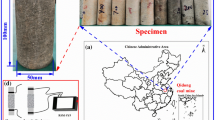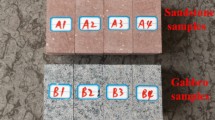Abstract
Acoustic emission (AE) from quartz during heating was measured with a high resolution decrepitometer on more than 350 samples from various conditions of formation and geological settings. The emitted acoustic signals can accumulate in very sharp peaks or extend over a wide temperature range. Different types and conditions of quartz formation can be distinguished from total counts and individual AE-patterns. Correlation of the determined AE peaks with microthermometric investigations, optical and scanning electron microscopical (SEM) studies of polished and etched thin sections showed that the sound, generated during heating, is caused by several distinguishable mechanisms. The main cause is the thermal expansion mismatch and thermal anisotropy of the quartz. In all cases the sound is emitted from opening and propagating microcracks. At temperatures below 380° C the main sources of AE are the rupture of grain boundaries, transgranular fracturing and decrepitation of large fluid inclusions. In the temperature range of 350–550° C, intragranular fracturing, sometimes enhanced by Brasil twinning, and reopening of healed fissures, often decorated with large numbers of small secondary fluid inclusions, cause distinct peaks of acoustic emission. At the α-β inversion temperature (≈ 573° C) massive emission of sound occurs if the quartz is twinned according to the Dauphiné law. Measurement of AE can help to determine critical temperatures of material failure and reveal information on the residual strain in rocks. Different generations of quartz veins can be distinguished, even if covered by soil and the extent of alteration zones can be determined by the varying AE patterns.
Similar content being viewed by others
References
Aines K, Kirby SH, Rossman GR (1984) Hydrogen speciation in synthetic quartz. Phys Chem Minerals 11:204–212
Balderman MA (1974) The effect of strain rate and temperature on the yield point of hydrolytically weakened synthetic quartz. J Geophys Res 79:1653–1661
Behr H-J, Frentzel-Beyme K (1988) SEM-Cathodoluminescence Studies of Palaeoporosity in Metamorphic Rocks. In: Emmermann R, Giese P (eds) (Projektleitung KTB der BRD im NLfB) Beiträge zum 1. KTB-Kolloquium Gießen Jan. 1988, KTB REPORT 88-10:63
Behr H-J, Schmidt Mumm A (1987) The role of sedimentary and tectonic brines in the Damara Orogen, Namibia. Appl Geochem 2:535–542
Bodnar RJ, Binns PR, Hall DL (1989) Synthetic fluid inclusions VI. Quantitative evaluation of the decrepitation behaviour of fluid inclusions in quartz at one atmosphere confining pressure. J Metamorph Geol 7:229–242
Boiko VS, Garber RI, Kivenko LF, Krivulya SS (1970 a) Sound emission of twinning dislocations during their emergence from the crystal. Sov Phys —Solid State 11:3041–3042
Boiko VS, Garber RI, Kivenko LF, Krivulya SS (1970b) Acoustic radiation by twinning dislocations. Sov Phys — Solid State 12:1387–1388
Brunner GO, Wondratschek H, Laves F (1961) Ultrarotuntersuchungen über den Einbau von H in natürlichen Quarzen. Z Elektrochem 65:735–750
Burlinson K (1984) Exploration for gold at pine creek and tennan creek, N.T. and at halls creek, W.A. using the fluid inclusion decrepitation technique. The Aus. I.M.M. Conference, Darwin, N.T., August 1984, Abstract volume
Chryssoulis SL, Rankin AH (1988) Decrepitometry of fluid inclusions in quartz from Guadalcazar granite of Mexico; Principles and application to mineral exploration. Mineral Deposita 23:42–49
Fredrich JT, Wong TF (1986) Micromechanics of thermally induced cracking in three crustal rocks. J Geophys Res 91 612:12743–12764
Frondel C (1945) Secondary Dauphiné twinning in quartz. Am Mineral 30:447–467
Gault HR (1949) The frequency of twinning types in quartz cristals. Am Mineral 34:142–162
Griggs D (1974) A model of hydrolytic weakening in quartz. J Geophys Res 79:1653–1661
Hladky G, Wilkins RWT (1987) A new approach to fluid inclusion decrepitometry —practice. Chem Geol 61:37–45
Hobbs BE (1985) The hydrolytic weakening effect in quartz. In: Schock RN (ed) Point defects in minerals. Am Geophys Union Monograph 31: Fallen Leaf. Calif, pp 151–170
Hurlbutt CS Jr (1946) Influence of twinning on the usability of quartz. Am Mineral 31:443–455
Keith ML, Tuttle OF (1952) Significance of variation in the high low inversion of quartz. Am J Sci Bowen Volume: 203-280
Laughner JW, Cline TW, Newnham RE, Cross LE (1979) Acoustic emission from stress induced Dauphiné twinning in quartz. Phys Chem Minerals 4:129–137
Leroy J (1979) Contribution à l'etalonnage de la pression interne des inclusions fluides lor de leur décrépitation. Bull Minéral 102:584–593
McLaren AC, Cook RF, Hyde ST, Tobin RC (1983) The mechanisms of formation and growth of water bubbles and associated dislocation loops in synthetic quartz. Phys Chem Minerals 9:79–94
McLaren AC, Fitz Gerald JD, Gerretsen J (1989) Dislocation Nucleation and Multiplication in Synthetic Quartz: Relevance to Water Weakening. Phys Chem Minerals 16:465–482
Mix PE (1987) Acoustic Emission. In: Mix PE (ed) Introduction to Nondestructive Testing, A Training Guide. Chapter 9. Wiley, New York, pp 269–285
Parks AG (1984) Surface and interfacial free energies in quartz. J Geophys Res 89:3997–4008
Pashkov YN, Piloyan GO (1973) On the theory of the decrepitation method: Abstracts of papers at Fourth Regional Conference on Thermobarochemistry of Mineral-Forming Processes 24–30 Sept 1973: Rostov, Rostov Univ Press. 292–293. In: COFFI 6:119
Paterson MS, Kekulawala KRSS (1979) The role of water in quartz deformation. Bull Mineral 102:92–98
Peach PA (1949) The decrepitation geothermometer. Am Mineral 34:413–421
Schmidt Mumm A (1989) Die Entwicklung der Fluid-Systeme während der obeproterozoischen Damara-Orogenese am Südrand des Damara-Orogens Namibia. Göttinger Arb Geol Pal 41, p 93
Schmidt Mumm A, Behr H-J (1990) Discrimination of Quartz Generations by Acoustic Emission Analysis. In: KTB REPORT 90-4 Beiträge zum 3. KTB-Kolloquium Gießen 1990 (in Press)
Schubnikov A, Zinserling K (1932) Über die Schlag-und Druckfiguren und über die mechanischen Quarzzwillinge. Zeitschr Kristallogr 83:243–265
Scott HS (1948) The decrepitation method applied to minerals with fluid inclusions. Econ Geol 45:637–645
Sharonov BN, Lir YV, Kozlov AV (1973) On question of interpretation of decrepigraphs of vein quartz: Abstracts of papers at Fourth Regional Conference on Thermobarochemistry of Mineral-Forming Processes, 24–30 Sept 1973: Rostov Rostov Univ Press: 309-311. In: COFFI 7:203–204
Smith FG (1950) A method of determining the direction of flow of hydrothermal solutions. Econ Geol 45:62–69
Smith FG, Peach PA (1949) Apparatus for the recording of decrepitation in minerals. Econ Geol 44:449–451
Sterner SM, Bodnar RJ (1989) Synthetic Fluid Inclusions-VII. Reequilibration of Fluid Inclusions in Quartz During LaboratorySimulated Metamorphic Burial and Uplift. J Metamorph Geol 7:243–260
Swanenburg HEC (1980) Fluid inclusions in high grade metamorphic rocks from S.W. Norway. Geologica Ultraiectina University of Utrecht 25:147
Tuttle OF, Bowen NL (1958) Origin of granite in the light of experimental studies in the system NaAlSi3O8-KAlSi3O8-SiO2-H2O. Geol Soc Am Mem 74:29–35
Ulrichova D, Bradac L (1971) Decrepitation and optical methods applied to inclusions in minerals [in Russian]. Vestnik uuG 46:193–208
Wegner MW, Christie JM (1983) Chemical etching of deformation substructures in quartz. Phys Chem Minerals 9:67–76
Wolter KE, Aulbach E, Berckhemer H (1988) Spannungsnachwirkungsuntersuchungen: — Messung der Retardation und der akustischen Emission: D Geophysik-KTB Report 6-88:D47–D60
Author information
Authors and Affiliations
Rights and permissions
About this article
Cite this article
Schmidt-Mumm, A. Low frequency acoustic emission from quartz upon heating from 90 to 610° C. Phys Chem Minerals 17, 545–553 (1991). https://doi.org/10.1007/BF00202233
Received:
Issue Date:
DOI: https://doi.org/10.1007/BF00202233




